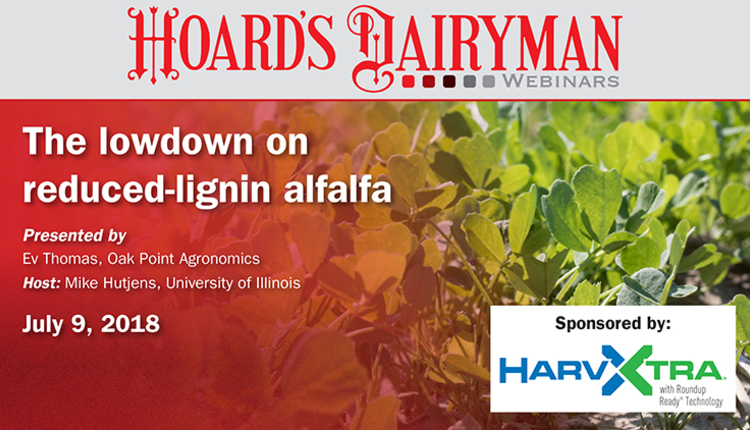
“It’s a game changer,” shared Ev Thomas of Oak Point Agronomics during the Hoard’s Dairyman webinar, when talking about forage advancements in alfalfa production.
Improvements in alfalfa yield and quality have been slow. Not until recently have there been significant advancements in the genetic field. Historically, we have seen enhancements limited to disease-resistant varieties.
This new era is focusing on reducing the lignin in forage, therefore improving fiber digestibility for dairy cattle. “These reduced-lignin options are creating the most exciting time in alfalfa production in 50 years,” shared Thomas.
Improvements have involved both conventionally-bred and genetically-engineered varieties. The result is higher forage quality and the potential to enhance yield and stand longevity.
Technology has allowed a wider window for forage harvesting without sacrificing forage quality. This is beneficial when growers want to, or need to, delay harvest. An additional result is that a longer growing window may trim the number of cuttings in a field. While one might think that would cause a yield decline, it may actually do the opposite. The University of Minnesota and the University of Wisconsin’s research both showed improved yields with one less cutting because the plants gain yield each day with a longer growing cycle.
Two secondary benefits include less harvesting labor costs for an additional cutting, and less plant crown damage from reduced wheel traffic.
Maybe the best benefit is the flexibility for farmers. With reduced-lignin varieties, they are able to tailor their schedules for their individual farms.
Some growers will seed grasses with their alfalfa. That practice is still a viable option with reduced-lignin varieties, but pay careful attention to the grass’ maturity schedule. Be sure it works in tandem with the alfalfa and does not mature ahead of the alfalfa. Thomas was very favorable to meadow fescue’s ability to be seeded with reduced-lignin alfalfa.
Typically with cost-saving measures or labor-saving ventures, there is an associated additional cost. This is also true for reduced-lignin. However, if properly managed, the investment in reduced-lignin alfalfa will be recuperated in higher yields and/or greater ration digestibility.
While reduced-lignin varieties have jump-started excitement around alfalfa, Thomas expects even more developments in this area. He believes they will come sooner rather than later. “There is a steep learning curve. We’ll know a lot more about reduced-lignin alfalfa in a year or two,” concluded Thomas.
The July webinar was sponsored by HarvXtra and is archived on our website.
Join us next month:

Mike Hutjens, University of Illinois, will present “What’s different about Jerseys . . . and what’s not” on Monday, August 13, at noon (Central time).
Hutjens will discuss guidelines and opportunities for Jersey herds based on the results of a thorough study of the top cheese yielding Jersey herds in the country. The impact of herd size, milk yield, use of BST, and mixed breed versus Jersey-only farms will be evaluated. The webinar is sponsored by KTG. Register here for all webinars.

The author is the online media manager and is responsible for the website, webinars, and social media. A graduate of Modesto Junior College and Fresno State, she was raised on a California dairy and frequently blogs on youth programs and consumer issues.








